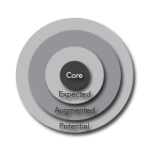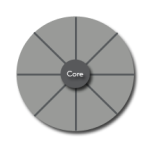Many of us are familiar with the Whole Product concept which was developed by the Partners at Regis McKenna. However, like many ideas and concepts, it has its roots in earlier work. In this case, it was the work of Ted Leavitt, a professor at Harvard Business School who outlined something he called the total product in his book “The Marketing Imagination” one of the titles in my top 21 high technology marketing books.
The Total Product
Leavitt drew attention to the fa ct the consumers (B2B or B2C) don’t just purchase the product itself, but rather, the product and other expected and augmented attributes, which were often intangible. The total product was Leavitt’s vision of how less tangible elements could be added to a product that had certain physical attributes, imbuing it with other dimensions that were often more valuable than those physical attributes.
ct the consumers (B2B or B2C) don’t just purchase the product itself, but rather, the product and other expected and augmented attributes, which were often intangible. The total product was Leavitt’s vision of how less tangible elements could be added to a product that had certain physical attributes, imbuing it with other dimensions that were often more valuable than those physical attributes.
To completely understand the Whole Product concept, we will need to meld Roger’s Diffusion of Innovation with the Whole Product in another post.
The Whole Product
 The principal augmentation by the partners to the Total Product was to collapse the outer layers of Leavitt’s Total Product and divide them into segments representing other key factors that influenced high technology purchases. Otherwise, why would you pay say, $300 for a Mont Blanc pen, when the same refill will fit in other, much-less-expensive pens?
The principal augmentation by the partners to the Total Product was to collapse the outer layers of Leavitt’s Total Product and divide them into segments representing other key factors that influenced high technology purchases. Otherwise, why would you pay say, $300 for a Mont Blanc pen, when the same refill will fit in other, much-less-expensive pens?
The sectors need to be uniquely defined for each product and a potential list is outlined below.
Tangible and Intangible Sectors
The sectors actually break down into two groups: What you actually provide that is tangible and everything else the customer needs to make the product acceptable to them as a solution. The number could be small or it could be large like this, as suggested to a large B2B telecommunications equipment manufacturer :
Whole Product Elements
▪ Shared vision
▪ Open systems structures
▪ Best of breed
▪ Support (system administration, network management, facility control)
▪ Flexibility
▪ Value for price
▪ Reputation
▪ Track record
▪ Relationships
▪ References
▪ Cultural fit/compatibility
▪ Force in technology
▪ Financially stable/growing
▪ Service
▪ Creative and innovative
▪ Good migration path
▪ Complementary fit (to existing infrastructure)
▪ Ability to scale to meet our needs
Although the list in the above case is daunting, it’s because the market segment was relatively mature. As such the number of factors often increases. The further you are from the Chasm (presuming you have crossed it), the shorter the list is.
How Do I Identify the Sectors?
Talk to your target market and your existing customers. Research the real reasons why they purchased. Even better, find out why prospects bought a competitor’s solution, or postponed the decision entirely. Look at what successful competitors are doing … But … Don’t blindly copy them. You have different resources and product portfolios … look for inspiration not duplication.


